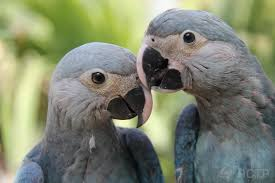Recent Extinctions:
Since the year 2000, the world has lost thousands of species—some quietly, without anyone noticing, and others remembered only because of a famous last individual. These extinctions are not just stories of animals disappearing; they are stories of ecosystems unraveling, of human impact reaching too far, and of warnings that went unheard. Below are some of the most striking examples of animals that have vanished in just the past two decades, each leaving behind a lesson about the fragile balance of life on Earth.
1. Spix’s Macaw (2019 – Wild Extinction)
Known as the “Little Blue Macaw,” this stunning parrot from Brazil became famous from the movie Rio. Sadly, habitat loss and illegal pet trade pushed it out of the wild. Although a few survive in captivity, it vanished from its natural home—showing how human greed can erase even the most beautiful species.
2. Pyrenean Ibex (2000)
Native to the mountains of Spain, this wild goat was officially declared extinct in 2000. Overhunting and habitat loss caused its decline. Scientists even attempted to bring it back through cloning in 2003—the first species ever “de-extincted”—but the clone only survived a few minutes. Its story shows both the tragedy of extinction and the limits of human technology.
3. Yangtze River Dolphin (Baiji) (2006)
Once called the “Goddess of the Yangtze,” this freshwater dolphin swam China’s longest river for millions of years. Pollution, overfishing, and boat traffic caused its population to collapse. By 2006, surveys confirmed it functionally extinct—the first dolphin driven extinct by human activity. Its loss is a chilling warning about what happens when industrial growth outruns environmental care.
4. Pinta Island Tortoise (2012)
Made famous by Lonesome George, the last of his kind, this Galápagos giant tortoise species disappeared forever when he died in 2012. Once hunted for food and threatened by invasive species, George’s lonely end became a global symbol of extinction—and a call to act before other species reach the same fate.








5. Golden Toad (2004, Costa Rica)
This tiny, brilliantly colored toad once shimmered like living gold in the cloud forests of Costa Rica. First discovered in 1964, it became a symbol of the region’s biodiversity. But within just a few decades, climate change and a deadly fungal disease wiped it out. By 2004, the species was declared extinct—one of the first victims of global warming.
6. Christmas Island Pipistrelle (2009, Australia)
Barely the size of a human thumb, this bat played a huge role in controlling insects on Christmas Island. Invasive species, habitat destruction, and human neglect drove it to the brink. In 2009, scientists recorded its final echolocation call, and then silence—marking the heartbreaking extinction of an entire species in real time.
7. Formosan Clouded Leopard (2013, Taiwan)
This elusive big cat once prowled the misty forests of Taiwan, revered in local culture and feared as a skilled hunter. Sadly, deforestation and hunting destroyed its numbers. After decades without confirmed sightings, it was declared extinct in 2013. Its disappearance shows how quickly even powerful predators can vanish when their forests are cut down.
8. Rabbs’ Fringe-Limbed Treefrog (2016, Panama)
With long webbed fingers that let it glide between trees, this unique frog was unlike any other. But a devastating fungal disease swept through Central America’s amphibians, erasing entire populations. The last known individual, a frog named “Toughie,” lived in captivity until 2016—his lonely death marked the end of the species, and a symbol of the global amphibian crisis.
9. Western Black Rhino (2011, Africa)
Once roaming the savannas of Central Africa, the Western Black Rhino was a powerful yet gentle grazer. Relentless poaching for its horn decimated its numbers despite conservation efforts. In 2011, it was officially declared extinct. Its loss stands as one of the clearest examples of how human greed can drive even the most iconic animals off the face of the Earth.










While each of these animals has its own story, they all share something in common—the forces that drove them to extinction. Understanding the causes behind these losses, and the impact they leave on our planet, is the key to preventing more species from meeting the same fate.

